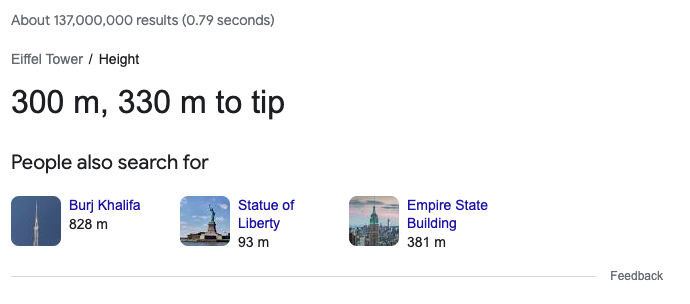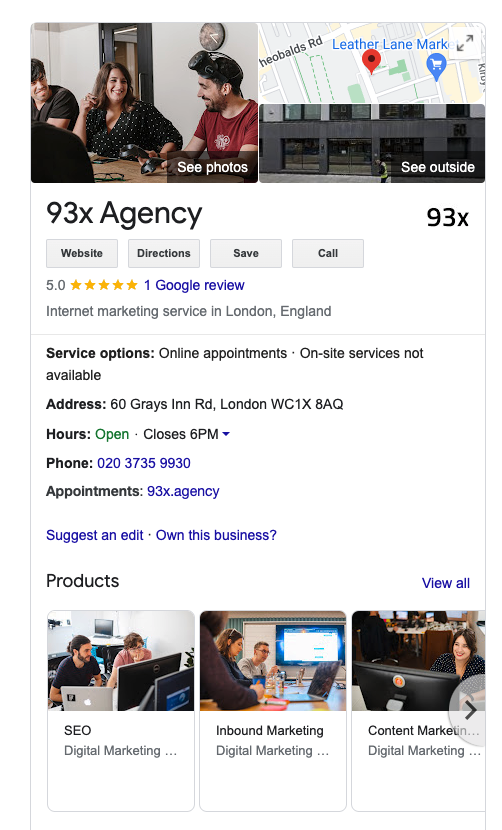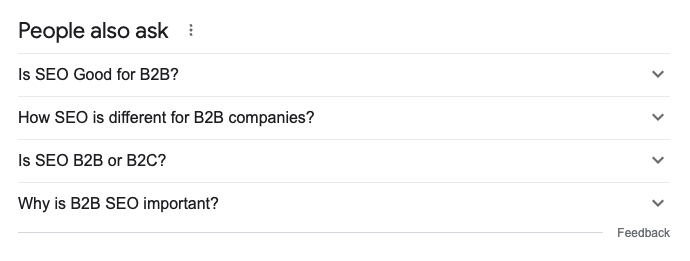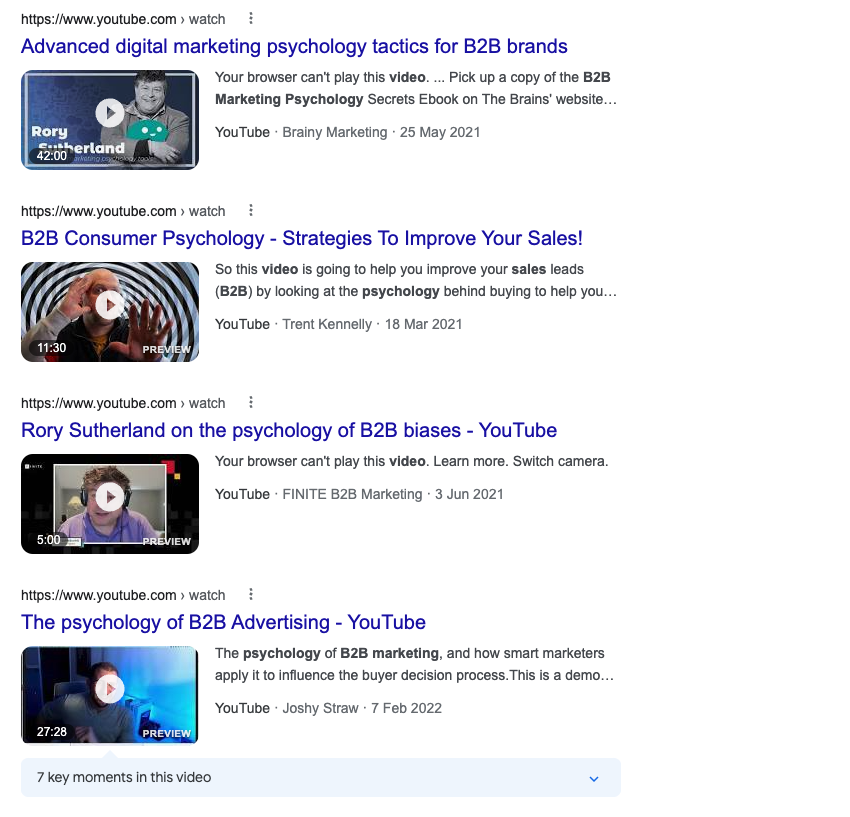The importance of SERP features in B2B SEO
Understanding search engine results page (SERP) features is an essential part of search engine optimization (SEO) for B2B companies. In this article, we’ll discuss what SERP features are, and give you a rundown of some of the main types of SERP features. We’ll also explain why they’re so important as part of your overall B2B SEO strategy.
We’ll focus mainly on Google in this article, given that it currently accounts for 91.6% of the market share worldwide. But keep in mind that other search engines such as Bing and Yahoo follow similar principles.
What are SERP features?
SERP features, also commonly known as “rich results”, are any search results that are not traditional organic search results and can include featured snippets, knowledge graphs, and ‘People also ask’ Q&As.
So a SERP feature is basically anything other than the traditional “ten blue links” that show up on the SERP whenever you search for something online. While they haven’t always been present on Google, they have been showing up increasingly often over the past few years.
The main purpose of SERP features is to provide information in the search results without requiring the user to click on a link. The type of SERP features you will see on a SERP depend largely on your search query.
First of all, let’s briefly go over the four key types of search queries:
- Navigational queries are when someone is looking for a particular website, but doesn’t enter the full URL to get to it directly.
- Informational queries are when someone is looking to find the answer to something, and isn’t usually looking to make a purchase.
- Transactional queries are when someone is looking to buy something.
- Commercial queries are when someone has the intent to purchase, and is exploring what different options are available.
Every SERP is unique – even when people use the same search query. This is because the results you are presented with depend on multiple factors such as your location, previous search history, age, and so on. Although two SERPs might look very similar, you’ll often notice that they have slightly different SERP features if you look closely.
How exactly do SERPs work?
Although it’s impossible to know exactly how SERPs work due to the ever-changing search engine algorithms, here’s a quick breakdown of the three stages that Google uses to determine what it will show a user:
- Bots crawl the web to find new pages (approximately 175 new websites are created every single minute!) or pages that have recently been updated to index on the web.
- Bots index these pages by inserting information from them (including the URL, images, tags, content, etc.) into a database.
- Bots determine which pages are most relevant for specific search queries to determine what information should be presented to users.
As you’ve probably noticed, the last step in particular is extremely vague. But you can improve your chances of your content being recognised by algorithms by creating content that is of high quality, and implementing a robust SEO strategy.
Different types of SERP features
There are many different types of SERP features, but each one will typically fall into one of the following four categories:
- Paid results, which are bought by bidding on relevant keywords via platforms such as Google Ads (formerly known as AdWords) or Google Shopping. These results usually feature a label to make it clear that they are ads. Paid results at the top of the page usually push down organic pages on the SERP.
- Rich snippets, which add additional information to an existing result. They are often used in shopping results, for example, as a price or as review stars for products.
- Universal results, which appear alongside organic results. They might be image results or news results, for example.
- Knowledge graph data, which appears in panels or boxes on the SERP.
What are the most common SERP features?
Now, we’ll go through some of the most common SERP features. While it will be difficult for B2B companies to leverage some of these features, it is possible to take advantage of others by combining an excellent piece of content with the right B2B SEO strategy. Where this is possible, we have explained how you can increase the chances of leveraging SERP features to reach your target audience.
Image Packs

Image packs are horizontal rows of images that click through to a Google Images search page. They are displayed when the algorithm decides that visual content would be valuable. They can appear in any position on the SERP.
To optimise your images to feature in an Image Pack, you should include a descriptive file name and alt text, a readable URL, an optimised image size, and a title attribute.
Knowledge Cards

The Google Knowledge Graph gathers data from multiple sources across the web to provide concise answers to commonly asked questions.
Knowledge Panels

If you often search on your desktop, you’re probably very familiar with Knowledge Panels. They appear to the right of search results, and typically display the most relevant and popular information for a topic.
Similar to Knowledge Cards, most of the data displayed in Knowledge Panels comes from the Google Knowledge Graph. According to information published by Google, Wikipedia is a commonly-cited source – but it is not the only one.
Featured Snippets
Featured Snippets are large boxes that highlight a specific section of a result page. They contain more information than a typical search result, and act as a quick way for users to find out about a topic without having to click through too many websites to find out more. They also link to the source of the information. They are usually displayed at the top of a web page.
If you’re ranking in the top five for a specific query, then you have a chance of appearing in featured snippets. This is great news, because featured snippets have significantly higher click-through rates (CTRs) than regular results, despite presenting all the information a user might need to know.
Featured snippets are particularly valuable for B2B tech companies who are looking to optimise their website for search through educational content. They make a larger impact on a reader, and increase your status as a knowledgeable and specialised source of information.
People Also Ask (PAA)

If you type a question into Google, then it will automatically generate some further questions that it believes are related to the question you searched for. This is useful for users searching for a particular query, as it can help them to understand their question better and provide them with additional information that they might not have considered searching for.
This can also be extremely useful for B2B companies looking to widen their scope of target keywords for cluster content and topic ideas, as it allows them to understand what their target audience is searching for alongside main target keywords.
If you manage to win the “featured snippets” section for a keyword, there is also a good chance that you’ll appear in these dropdown boxes, as again, this is another source of quick information for the user.
Top and Bottom Google Ads

Top and bottom ads are displayed at the very top of the results page above organic search results, and at the very bottom of the results page below organic search results.
Both the cost and the difficulty of getting your ad on the SERP – especially if you want to get it at the top of the page so that people will see it before organic search results – depend on how competitive your keywords are. More competitive keywords will require a high pay-per-click bid, as well as a high quality website. So before you go plunging money into paid ads, make sure you’ve done your keyword research.
Video Carousels

Video carousels are video organic results that appear on the results page and are enhanced with a video thumbnail. They can be displayed horizontally or vertically. The videos featured on Google’s SERP are usually YouTube videos, but this is not always the case. Other pages with embedded videos are also eligible.
Video carousels typically show up less often than most of the other SERP features described above, but they still show up fairly often if the user enters the right keywords. You can make sure that your videos are eligible to appear as a SERP feature on Google by using schema markup.
Why are SERP features important in B2B SEO?
Getting to grips with SERPs can feel challenging. If you’re just starting out, it can feel almost overwhelming. There is a lot to learn, and search engines change their algorithms and policies frequently. As algorithms continue to evolve, getting a spot on the first page has become increasingly difficult.
However, the payoff of a good SEO strategy is worth it. Studies have shown that the #1 result on Google gets 31.7% of all clicks.
Optimising your website for SERP features increases your website’s ranking, and improves the chances of potential clients finding you online. It can also boost your reputation by positioning your business as a go-to source for answers to their search queries.
As a start, you can use the Google Rich Results Test to see if your page supports SERP features. Depending on your goals, you might want to consider working with a professional B2B SEO agency.
If you’re looking for a B2B SEO agency to boost your website ranking and domain authority, check out our B2B SEO services here, and learn about our specialism in B2B tech and SaaS.
